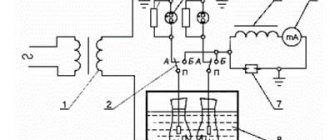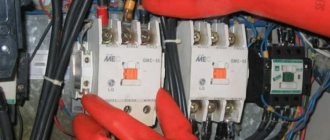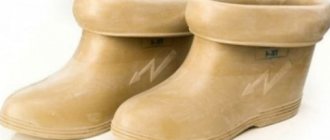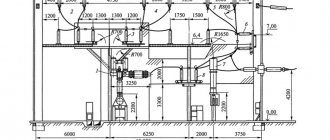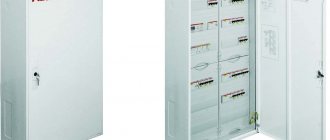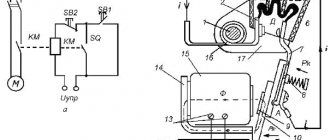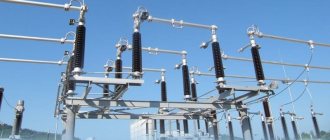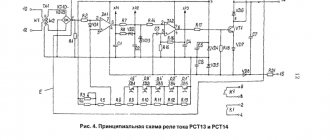Among the protective equipment designed to protect a person from possible electric shock, dielectric gloves are the most famous. They allow you to touch bare conductors and perform a number of household and industrial repairs quickly and safely. Anyone can afford gloves; they are easy to use and are an integral attribute of every electrician. However, the low level of information about dielectric gloves leads to their incorrect use, and in this article we will talk about the main points that you should familiarize yourself with.
Purpose
Dielectric gloves are designed to protect human hands from direct or indirect contact with live parts while performing any technological processes in low-voltage circuits. As a protective agent, they occupy two categories - basic and additional in accordance with clause 1.1.6 SO 153-34.03.603-2003.
Rice. 1. Use of gloves as the main means
Thus, in circuits up to 1000 V they can be used as the main protective device, that is, one whose dielectric properties will be more than sufficient for direct contact with a rated voltage source. And in networks above 1000 V, they act as an additional means of protection, which is used to touch live elements of electrical installations only through tools and devices with a sufficient level of insulation.
Rice. 2. Use of gloves as an additional means
In practice, gloves are used to directly touch live cable conductors to find damage or carry out any repair work. They are also used in work where direct hand contact with live parts is not required, but there is a possibility of accidental contact. As a mandatory element of hand protection when hanging grounding connections, performing operations with operational, testing and measuring rods.
Storage rules and protection from deformation and damage
The rules for using dielectric gloves require compliance with certain storage rules. In particular, to maintain their performance characteristics, protective products should be thoroughly cleaned of dirt immediately after work - for this, soap and water are used, as well as special disinfectants that are harmless to rubber and latex. After cleaning, the mittens must be dried.
When storing, dielectric gloves and boots must be protected from direct sunlight and avoid contact with oils, acids, and gasoline. In the room where protective equipment is stored, a certain temperature regime must be observed - from -30C to +40C - there is no high humidity or dust.
Dielectric gloves are a universal and reliable means of protection when performing electrical work. The use of dense rubber and latex makes it possible to ensure a long service life of the products, but it can be extended even further if you do not wrinkle the protective equipment during work, put them on correctly and do not use them openly in installations where there are sharp edges. For example, leather mittens can be worn over gloves.
Classification
The modern market provides a fairly wide range of dielectric gloves to solve a wide variety of problems. Some models are designed for highly specialized industries and the national economy, others are universal and suitable for almost any equipment.
Structurally, all dielectric gloves are divided into:
- suture - a universal model that functions perfectly both in open electrical installations and in closed switchgear;
- seamless - most relevant for closed electrical installations, as they are quickly destroyed under the influence of ultraviolet radiation;
- five-fingered - used in work with complex technological operations;
- two-fingered - used in simple technological processes where a strong hand grip is required.
The main criterion for the protection of dielectric gloves is the level of operating voltage that can be touched. Therefore, for different voltage classes there is a special gradation:
- 00 – intended for household networks where the voltage does not exceed 220 V;
- 0 – for power equipment systems up to 1000 V (380 V, 600 V, 800 V);
- 1 – represent products with a tolerance level of up to 7500 V;
- 2 – glove class up to 17,000 V;
- 3 and 4 - regulated for electrical equipment where the voltage does not exceed 26,500 and 36,000 V, respectively, for each class.
In addition to classic dielectric gloves, the following types are used in practice:
- gaiter - equipped with an enlarged bell, which makes it easier to put it on a thick sleeve;
- composite – additionally protected from mechanical damage;
- contour – with widening at the wrist, making it easier to bend the arm;
- with lining – has a textile layer fixed in an elastomer;
- extended – allows you to protect your arm up to the shoulder.
Procedure for using protective equipment
According to the current Rules, PPE, as inventory property, must be stored in premises designated for this purpose and issued to field teams or for individual use.
Only those protective equipment in electrical installations that have passed tests are allowed for use, and there is a corresponding entry on the product stamp.
As for the norms of distribution, they depend on internal regulations, which take into account the characteristic conditions in a particular organization. But at the same time, violations of the requirements of safety and labor protection standards are not allowed. When distributing, information about storage locations is required to be retained. For this purpose, special lists are provided, recorded with the signature of the responsible person and the seal of the organization.
If during the testing process or during an external inspection unsuitable personal protective equipment is identified, they are subject to write-off, followed by removal from the storage location. Information about this should be reflected in the protective equipment record book or operational documents, for example, when the unsuitability of personal protective equipment is discovered on the road.
Electrical personnel, after receiving PPE in hand, bears full responsibility for compliance with operating rules and must be able to independently determine their current condition, as far as possible under working conditions. In this case we are talking about external inspection for integrity.
Protective equipment in electrical installations intended for enclosed spaces can be used in open spaces, but only if the weather is dry. In case of frost, rain or high humidity, it is necessary to use specialized tools designed for use in such weather conditions. A note on the relevant electrical tests must be included in the product passport.
Before starting to operate PPE, electrical personnel are required to check for any punctures in the insulation or other damage. It is mandatory to check the permissible service life and the date of the last tests. This information is contained in the stamp. It is strictly prohibited to use expired protective equipment during work!
To avoid exposure to touch voltage, do not touch the working surfaces of PPE during operation, as well as insulating parts outside the limiting stop or ring.
Requirements
The main requirement for dielectric protective equipment is strict compliance of a particular product with the conditions in which it will be used. The use of certain models should ensure the possibility of wearing knitted mittens in the cold season. All dielectric gloves must be stored in pairs; their separation and single use are not allowed.
On the gloves themselves, in accordance with clause 1.4.5 SO 153-34.03.603-2003, a stamp is placed on the edge using indelible paint, which indicates the following information about the product:
- number – determined individually at each enterprise;
- next test date;
- name of the laboratory that performed the tests.
In the event that a product has not passed the required tests, such a stamp should be crossed out with a red line, indicating their unsuitability.
Types and features of special-purpose gloves
The range of dielectric gloves is not very extensive. The main materials for the manufacture of workwear are thick sheet rubber and latex. The sizes of the products are shaped in such a way that the worker can wear warm mittens under them during the cold season. The gloves have a standard length of 35 cm and are worn over the sleeves of clothing in order to eliminate the slightest chance of electrical sparks hitting a person.
Hand protection when working with electrical equipment and networks is divided into several categories:
- Two- and five-fingered. The latter type of gloves is more convenient, as it allows you to fully use the entire hand, simplifying the process of repairing electrical equipment and installing wiring.
- Seamless and with seam. Dielectric suture gloves (drilled) are made of dense rubber and the presence of a seam is provided for in the design. However, such products are quite comfortable and lightweight.
- For work with electrical networks up to 1000V (designation Ev) and over 1000V (marking En).
Characteristics
3. Length of the dielectric glove In accordance with the requirements of clause 2.10.3 SO 153-34.03.603-2003, the length of the gloves must be at least 350 mm. The edge of the gloves must be so wide that they can be easily worn over the sleeves of workwear.
According to clause 2.10.2 SO 153-34.03.603-2003, only models marked “Ev” and En are applicable for electrical installations. Here, the “Ev” grades represent an additional means of protection, which is used for operation in networks above 1000 V. “En” is intended for use as the main means of protection in lines and devices up to 1000 V.
Rice. 4. En marking
In accordance with clause 4.1 of GOST 12.4.307-2016, the practical use of dielectric gloves may require special properties of the product, namely:
- A – acid resistant;
- H – resistant to oil;
- Z – is resistant to ozone;
- R – combines the previous categories and is resistant to acid, oil, ozone;
- C – resistant to ultra-low temperatures;
- F – for gloves with an extended cuff, resistant to current leakage.
Based on the thickness of the material, dielectric gloves are divided into thin (with a thickness of at least 4 mm), regular and hard (with a thickness of 9 mm or more).
Test technology
The electrical protective characteristics of rubber and latex gloves should be checked every six months. Products that have passed the test period cannot be used.
Do not forget that this deadline was not assigned by chance, and do not miss timely checks. After all, over time, the dielectric properties of the mittens may decrease or disappear completely (due to intensive use or violation of storage rules). The use of poor quality PPE can result in a worker being seriously injured due to electric shock.
Tests are carried out using a metal container with water heated to 20-40°C and a test transformer. The mittens are lowered into a tank of warm water so that the liquid fills them from the outside and inside. The top of the mittens protrudes about 4-5 cm above the surface of the water; this part should remain dry.
One terminal of the transformer is connected to the tank, and the other is grounded. Electrodes are placed in the gloves and connected to ground via a milliammeter. To check the properties, an electric current is passed through the product. If sharp fluctuations occur or the current exceeds the norm, dielectric gloves are rejected. A breakdown indicates a violation of the tightness; such mittens are also prohibited from being used.
Rice. 8
Electrical insulating gloves are tested in accredited electrical laboratories in accordance with the requirements of TKP 290-2010. Information about the date of the next test of the electrical insulating properties of the product is applied to the stamp using a sticker or reprinting. A corresponding entry is also made in the test log.
Terms of use
Before using dielectric gloves, their integrity must be checked. Throughout the entire length of the product there must be no visible damage, cuts, tears, blackening of the material, mechanical or thermal deformation. If any are found, dielectric gloves are removed from service.
But, along with visible mechanical damage, rubber or polymers may contain punctures invisible to the human eye, which carry the same threat of electric shock as the absence of gloves. To check for such tears, gloves are checked by twisting before starting work.
Rice. 5. Testing gloves by twisting
The edge is folded and pressed along its entire length, then folded towards the fingers until the cavity is filled with air. After this, the condition of the inflated glove is monitored; if it does not deflate, the dielectric is considered intact.
Before use, the work manager or person in charge checks whether the next test date has expired. Dielectric gloves whose testing period has expired are subject to withdrawal.
Mandatory PPE check
Before using dielectric gloves to solve production problems, you need to ensure their suitability for use, as well as prepare PPE. First, an external inspection is performed. You need to check the following parameters:
- The condition of the surface of the product material is clean, free of moisture.
- Integrity – no cuts, tears or punctures are allowed.
- Compliance with the tactile characteristics of the material - products are not suitable for use if their surface is sticky, too soft or, conversely, hard and inelastic.
- Date of last test - make sure it is not yet time to test the product again.
- Shelf life - over time, gloves may lose their protective properties due to drying out and reducing the strength of the material.
Dirty or dusty mittens must be washed and dried thoroughly before use. In general, during use, PPE must be disinfected from time to time with soap or soda solution.
To check for leaks, the mitten must be twisted from the bell to the fingers. When it “inflates”, it needs to be lowered under water - the bubbles will clearly indicate the puncture site.
Rice. 6
How to check the integrity of dielectric gloves
Important! Cleanliness and absence of noticeable damage are insufficient conditions for allowing PPE to be used. It is also necessary to test their insulating properties using instrumental methods. Such checks are carried out in special laboratories.
To protect latex gloves from mechanical scratches or punctures, it is allowed to wear protective gloves made of thick leather or canvas on top while working. And we remind you that dielectric gloves cannot be rolled up during operation.
Rice. 7
How to put on hand PPE correctly
Verification and test timing
The most important criterion for dielectric gloves is the parameter of their ohmic resistance, that is, the ability to withstand the effects of electrical voltage for a long time. This parameter is checked in accordance with Appendix 7 SO 153-34.03.603-2003 once every 6 months by applying an increased voltage of 6 kV to the protective equipment for one minute. The testing mechanism is specified in clause 2.10.4 of the same instructions.
Rice. 6. Immersion of gloves in water
For testing, a bath of water is used, the temperature of which can range from +10°C to +40°C. In this case, gloves are put on metal conductive holders that act as one of the electrodes and immersed in a bath of water. Water is poured inside the mittens themselves, so that there is 45 to 55 mm left to the edge of the cuff; they remain dry.
Rice. 7. Diagram for testing dielectric gloves
As you can see in Figure 7, using transformer 1, voltage is supplied to bath 8 and through contacts 2 to the inside of the dielectric gloves. During the test, in addition to time intervals, the magnitude of the leakage current must be monitored, which should be no more than 6 mA. In the event of a breakdown, gas-discharge lamp 4 and spark gap 7 are activated to protect the installation from short circuit currents.
General rules for testing protective equipment
1.5. General rules for testing protective equipment
1.5.1. Acceptance, periodic and type tests are carried out at the manufacturer according to the standards given in Appendices 4 and 5, and the methods set out in the relevant standards or technical specifications.
1.5.2. In operation, protective equipment is subjected to regular and extraordinary operational tests (after a fall, repair, replacement of any parts, if there are signs of malfunction). The standards for operational tests and the timing of their implementation are given in Appendices 6 and 7.
1.5.3. Tests are carried out according to approved methods (instructions).
Mechanical tests are carried out before electrical tests.
1.5.4. All testing of protective equipment must be carried out by specially trained and certified personnel.
1.5.5. Before testing, each protective equipment must be carefully inspected to check the presence of manufacturer's markings, numbers, completeness, absence of mechanical damage, and the condition of insulating surfaces (for insulating protective equipment). If the protective equipment does not comply with the requirements of this Instruction, tests are not carried out until the identified deficiencies are eliminated.
1.5.6. Electrical tests should be carried out using alternating current at power frequency, usually at a temperature of plus (25 +/- 15) °C.
Electrical tests of insulating rods, voltage indicators, voltage indicators for checking phase coincidence, insulating and electrical clamps should begin with checking the dielectric strength of the insulation.
The rate of voltage rise to 1/3 of the test voltage can be arbitrary (a voltage equal to the specified voltage can be applied by a push); further increase in voltage should be smooth and fast, but allowing the readings of the measuring device to be read at a voltage of more than 3/4 of the test voltage. After reaching the rated value and holding at this value for a rated time, the voltage must be smoothly and quickly reduced to zero or to a value not exceeding 1/3 of the test voltage, after which the voltage is turned off.
1.5.7. The test voltage is applied to the insulating part of the protective equipment. In the absence of an appropriate voltage source for testing entire insulating rods, insulating parts of voltage indicators and voltage indicators for checking phase coincidence, etc. It is allowed to test them in parts. In this case, the insulating part is divided into sections to which a part of the normalized full test voltage is applied, proportional to the length of the section and increased by 20%.
1.5.8. Basic insulating electrical protective equipment intended for electrical installations with voltages above 1 to 35 kV inclusive are tested with a voltage equal to 3 times the linear voltage, but not lower than 40 kV, and those intended for electrical installations with voltages of 110 kV and above - equal to 3 times the phase voltage.
Additional insulating electrical protective equipment is tested by voltage according to the standards specified in Appendices 5 and 7.
1.5.9. The duration of application of the full test voltage is usually 1 min. for insulating protective equipment up to 1000 V and for insulation made of elastic materials and porcelain and 5 min. — for insulation from layered dielectrics.
For specific protective equipment and working parts, the duration of application of the test voltage is given in Appendices 5 and 7.
1.5.10. Currents flowing through the insulation of products are standardized for electrical protective equipment made of rubber and elastic polymer materials and insulating devices for live work. Operating currents flowing through voltage indicators up to 1000 V are also standardized.
Current values are given in Appendices 5 and 7.
1.5.11. Breakdown, flashover, and surface discharges are determined by turning off the testing facility during testing, by readings from measuring instruments, and visually.
1.5.12. Electrical protective equipment made of solid materials should be checked by touch immediately after testing for the absence of local heating due to dielectric losses.
1.5.13. If a breakdown, flashover or surface discharge occurs, the current through the product increases above the rated value, or local heating occurs, the protective equipment is rejected.
1.4. Accounting for protective equipment and monitoring their condition 1.4. Accounting for protective equipment and monitoring their condition
2. ELECTRICAL PROTECTIVE EQUIPMENT2. ELECTRICAL PROTECTIVE EQUIPMENT >>>
Storage
Dielectric gloves should be stored in a dry, clean place in a loose condition. It is strictly forbidden to twist or fold them, as this can lead to cracking and loss of dielectric properties. In the storage room, temperature fluctuations are allowed within the range from – 30°C to +40°C, humidity levels should be in the range from 40 to 60%. You should not leave them in close proximity to heating devices, dishes with alkali or acids, containers or mechanisms with mineral oils, as the impact of these factors reduces the dielectric properties.
If dielectric gloves are rejected, they should be stored separately from suitable ones in order to exclude human error.
I. SAFETY HELMETS
General purpose safety helmets
Hard shell made of high-strength polyethylene or polycarbonate. Weight up to 300 gr. Headband made of textile or plastic tapes with 4 - 6 attachment points. Easy adjustment to fit head size. The helmet must have:
- adjustable strap for proper attachment to the head;
sufficient head space for ventilation;
pockets for attaching glasses, headphones, shields;
The guaranteed shelf life of a helmet is the total period of storage and use. It is counted from the date of manufacture, which is marked on the inside of the visor.
ATTENTION: It is prohibited to perform any work with technological equipment or hand tools, or to be near such work without protective helmets!
1.3. Mandatory certification for compliance with GOST 12.4.128-83 and EN 397.
1.4. Manufacturers: Technoavaia, Uvex. 3M, Sacla, MSA Auer, etc.
1.5. Work using safety helmets:
- Work in areas marked with “Compulsory wearing of a helmet” signs.
Maintenance of technological equipment.
Lifting operations and movement of goods.
Construction works.
Warehouse work.
Work in areas where molten materials and chemicals may splash.
Work in the area of possible contact of the head with electrical wiring.
If there is a risk of head contact with low-lying structural elements.
Helmets are replaced in accordance with the manufacturers' recommendations, namely:
- After the expiration of the warranty period specified in the instructions for the helmet.
In case of damage or strong impact.
If the headband support band is damaged.
- Store protective helmets in dry rooms at temperatures up to +20C0, away from heating devices, avoiding direct sunlight (including near the rear window of the car)
Clean all plastic parts with aqueous cleaning solutions.
- Use helmets whose warranty period has expired.
Use helmets without headbands.
Modify the helmet shell or headband.
Carry any objects inside the helmet.
Paint helmets or remove marking stickers.
Dropping or throwing helmets, using them as stands, or using helmets for purposes other than their intended purpose.
Wear a helmet with the visor facing backwards.
- The industry produces helmets in six colors: white, blue, red, orange, yellow and brown.
White helmets are for management personnel of organizations and enterprises, heads of sections and workshops, public labor safety inspectors and safety officers.
Red helmets - for foremen, foremen, engineering and technical workers, chief mechanics and chief power engineers
Yellow and orange helmets are for workers and junior service personnel.
1-54-58cm; II - 58-62 cm.
Lifetime of protective accessory
Despite the fairly high cost of the product, according to GOST, such protective equipment can last no more than a year, provided that they are used at temperatures from -30 to +40 degrees Celsius. If the gloves are not used and are stored in a warehouse, the service life is not considered, that is, you can safely purchase a batch of gloves, put them in storage and not worry about the constant purchase of equipment for work.
On the other hand, in a folding room all storage rules must be observed so that gloves after long-term storage can be used for their intended purpose without risk to the employee.
Seamless gloves
Thanks to their design, seamless dielectric gloves allow you to work in more dangerous situations, because they are made of fairly strong rubber and simply cannot be molded so that there are no seams. Again, design in this situation is of no interest to anyone and the main task is to protect the worker’s fingers and palms from electric shock, a task they cope with very well.
Even with their thickness, the gloves remain quite light and flexible, you will not have the feeling that you are in a spacesuit and you can easily turn your hand or move your finger.
This version of gloves is in great demand due to the reliability and strength of the structure, since the thickness of the rubber here is really decent and this allows you to work even in those locations and situations where other types of protection cannot withstand or are simply not allowed for use.
No particular shortcomings were noticed; these gloves are heavier, but the difference is not so great that you feel an extra gram in the design. There are many more advantages here.
Photo of dielectric gloves
Read here! Voltage indicator: capabilities of modern devices and instructions for use. 100 photos of devices
How much are
When performing work involving current, dielectric gloves are therefore a must. Every electrician should use such a protective device at the enterprise. Such useful accessories are very inexpensive. For one pair of dielectric gloves, the company will have to pay about 200-500 rubles.
The shelf life of dielectric gloves may vary, depending on their purpose and class. For domestic dielectric gloves, according to GOST, the service life is usually 1 year. But of course, with intensive use, such accessories can lose their protective qualities much earlier.
